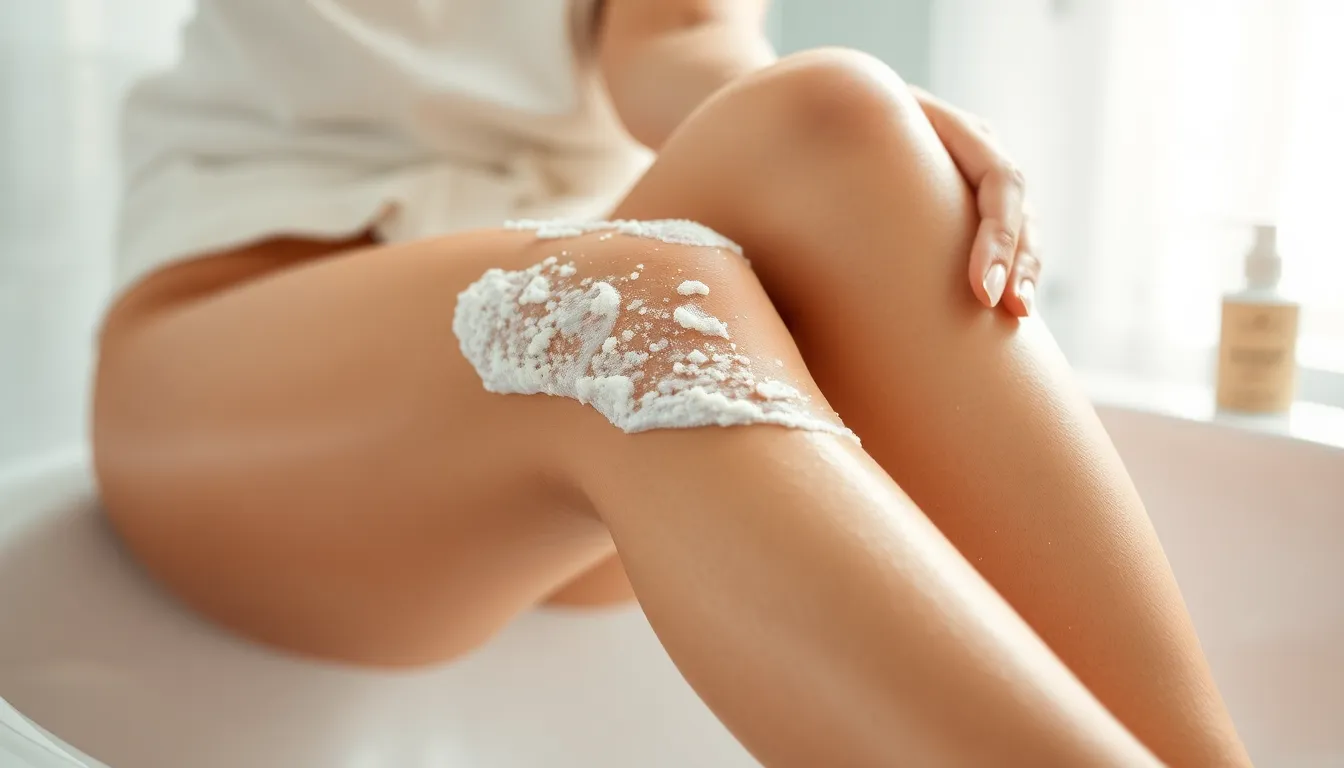Table of Contents
ToggleDealing with ingrown hairs on legs can feel like a never-ending battle. It’s like those pesky little hairs have a personal vendetta against smooth skin. But fear not! The right exfoliator can help you reclaim your legs and say goodbye to those unwanted bumps.
Imagine stepping out in your favorite shorts, confident and carefree, knowing your legs are as smooth as a baby’s bottom. With the best exfoliator for ingrown hairs, that dream can become a reality. These magical potions not only slough off dead skin but also encourage hair to break free from its underground lair. So get ready to ditch the discomfort and embrace silky, radiant legs that are ready for any adventure.
Overview of Ingrown Hairs
Ingrown hairs occur when hair follicles become blocked by dead skin cells, causing hair to grow sideways instead of upward. Many individuals experience ingrown hairs on legs, leading to irritation, redness, and sometimes painful bumps. These issues often arise after shaving, waxing, or using other hair removal methods that disrupt the natural hair growth cycle.
Ingrown hairs can affect anyone but are more prevalent in individuals with curly or coarse hair. The texture of the hair plays a significant role in how easily it becomes trapped beneath the skin. When hair grows back into the skin, it may also cause inflammation and even infection if not managed properly.
Effective exfoliation serves as a key method to prevent and treat ingrown hairs. A suitable exfoliator removes dead skin cells and unclogs hair follicles, promoting healthier hair growth. Regular use of an exfoliating product helps smooth the skin’s surface, allowing trapped hairs to emerge and reducing the risk of painful bumps.
Many types of exfoliators exist to address this issue. Physical exfoliators contain granules that manually scrub away dead skin, while chemical exfoliators use ingredients like alpha hydroxy acids to dissolve dead skin. Both options can contribute to smoother skin and minimize the occurrence of ingrown hairs.
Understanding the causes and prevention methods is crucial. Choosing the right exfoliator can significantly improve skin texture and reduce discomfort, allowing individuals to showcase their legs with confidence. Prioritizing skin care routines that include regular exfoliation creates the foundation for achieving smooth, radiant skin free from ingrown hairs.
Importance of Exfoliation

Exfoliation plays a crucial role in maintaining smooth skin, especially for those dealing with ingrown hairs on legs. Effective exfoliation removes dead skin cells and encourages trapped hairs to break through the skin surface.
How Exfoliation Helps
Exfoliation unclogs hair follicles, reducing the chances of ingrown hairs. It provides a pathway for hairs to emerge, minimizing irritation and discomfort. Regularly removing dead skin promotes healthier skin, leaving it soft and radiant. Chemical exfoliators, like glycolic acid, dissolve the bonds holding dead skin cells together, while physical exfoliators, such as scrubs, slough off the top layer. Both methods enhance skin texture and visibility of hair growth.
Recommended Exfoliation Frequency
Exfoliating two to three times a week proves effective for most individuals. This frequency allows the skin to rejuvenate without causing irritation. Those with sensitive skin should start slow, focusing on gentle exfoliating products. Adjusting the frequency based on individual skin responses ensures optimal results. Observing how skin reacts to exfoliation helps tailor routines for best outcomes.
Criteria for Best Exfoliators
Choosing the right exfoliator is essential for effectively managing ingrown hairs on legs. Several key factors influence the effectiveness of exfoliation products.
Ingredients to Look For
Salicylic acid efficiently penetrates pores, helping to dissolve dead skin cells and prevent hair follicles from becoming blocked. Glycolic acid, a popular alpha hydroxy acid, promotes cell turnover and enhances skin texture. Look for natural exfoliants like sugar or salt, which can gently remove dead skin without causing irritation. Tea tree oil offers antibacterial properties, aiding in reducing inflammation and preventing infections. Products containing aloe vera soothe skin, minimizing discomfort caused by exfoliation.
Types of Exfoliators: Physical vs Chemical
Physical exfoliators involve scrubs or brushes that manually remove dead skin. These options provide immediate results but may irritate sensitive skin if used excessively. Chemical exfoliators use acids or enzymes to dissolve dead skin without scrubbing. They often achieve deeper penetration, promoting a smoother skin surface. Many individuals find chemical exfoliators, such as those with salicylic or glycolic acid, more effective for preventing ingrown hairs. Each type offers benefits, so personal skin type should guide the selection.
Top Exfoliators for Ingrown Hairs on Legs
Finding the right exfoliator can significantly reduce ingrown hairs on legs. Below are three highly recommended products that deliver effective results.
Product 1: Review and Benefits
Paula’s Choice Skin Perfecting 2% BHA Liquid Exfoliant stands out with its salicylic acid formula. This product penetrates pores to dissolve dead skin cells, preventing blockages. Users appreciate its lightweight texture, which absorbs quickly without leaving residue. Regular application promotes smooth skin, reducing irritation from ingrown hairs. Many find that ongoing use leads to fewer bumps and a clearer complexion.
Product 2: Review and Benefits
Dermalogica Daily Microfoliant offers a unique rice-based powder exfoliant. Mixed with water, this product transforms into a creamy paste that gently exfoliates. It contains papain and salicylic acid, which work to enhance skin clarity. With daily use, individuals notice a significant decrease in inflammation and an increase in overall radiance. Its gentle formula suits various skin types, making it a versatile choice for those prone to ingrown hairs.
Product 3: Review and Benefits
First Aid Beauty KP Bump Eraser Body Scrub combines physical and chemical exfoliation methods. Its blend of glycolic and lactic acids promotes cell turnover effectively. Users value the coarse sugar particles that provide a manual scrubbing effect while being gentle on the skin. Regular application significantly decreases the appearance of bumps and rough patches. This exfoliator also includes soothing ingredients, enhancing comfort for sensitive skin.
How to Use Exfoliators Effectively
Using exfoliators correctly enhances their effectiveness for managing ingrown hairs. Start by choosing the right type based on skin type and sensitivity. Individuals with sensitive skin benefit from gentle, physical exfoliants, while those with resilient skin may opt for stronger chemical exfoliants containing salicylic or glycolic acid. Apply the exfoliator on clean, damp skin for optimal results.
Gently massage the product in circular motions for about one to two minutes. Rinse thoroughly with lukewarm water to avoid irritation. Consider exfoliating two to three times a week, allowing the skin to adjust to the regimen. He or she should monitor how the skin reacts, particularly during the initial applications.
Incorporating moisturizing products after exfoliation is crucial. Moisturizers hydrate the skin and create a barrier, helping to minimize irritation caused by exfoliation. The selection of a soothing moisturizer containing aloe vera or tea tree oil can provide added benefits, particularly for sensitive skin types.
For maximum effectiveness, focus on areas prone to ingrown hairs, such as the legs. Consistent exfoliation not only clears dead skin but also encourages trapped hairs to surface. Avoid aggressive scrubbing, as this can damage the skin and worsen irritation.
Adjust the frequency based on how the skin responds. If excessive redness or irritation occurs, reduce the usage to once a week or switch to a gentler product. Staying consistent with exfoliating practices leads to smoother skin and reduced discomfort, contributing to overall skin health.
Choosing the right exfoliator is essential for anyone struggling with ingrown hairs on their legs. Regular exfoliation not only helps prevent these pesky bumps but also promotes healthier skin overall. By incorporating products with effective ingredients like salicylic acid or glycolic acid into a skincare routine, individuals can achieve smoother skin and reduce irritation.
It’s important to tailor exfoliation frequency and method to individual skin types. With the right approach and consistent care, anyone can enjoy the confidence of beautifully smooth legs free from ingrown hairs. Prioritizing exfoliation will pave the way for a radiant appearance and improved skin texture.







